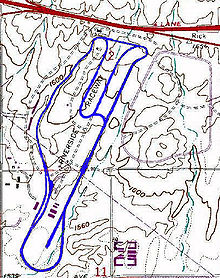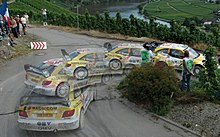Hairpin turn





A hairpin turn (also hairpin bend, hairpin corner, etc.), named for its resemblance to a hairpin/bobby pin, is a bend in a road with a very acute inner angle, making it necessary for an oncoming vehicle to turn almost 180° to continue on the road. Such turns in ramps and trails may be called switchbacks in American English, by analogy with switchback railways. In British English 'switchback' is more likely to refer to a heavily undulating road—a use extended from the rollercoaster and the other type of switchback railway.
Hairpin turns are often built when a route climbs up or down a steep slope, so that it can travel mostly across the slope with only moderate steepness, and are often arrayed in a zigzag pattern. Highways with repeating hairpin turns allow easier, safer ascents and descents of mountainous terrain than a direct, steep climb and descent, at the price of greater distances of travel. Highways of this style are also generally less costly to build and maintain than highways with tunnels.
On occasion, the road may loop completely, using a tunnel or bridge to cross itself (example on Reunion Island: 21°10′52″S 55°27′17″E / 21.18111°S 55.45472°E).
In trail building, an alternative to switchbacks is the stairway.
Roads with hairpin turns
Some roads with switchbacks (hairpin turns) include:
Europe
- Alpe d'Huez in the French Alps, famous for its 21 hairpin bends
- Stelvio Pass with its 48 Spitzkehren on the northern ramp is one of the most famous Alpine Mountain passes
- Transfăgărăşan in the Romanian Carpathians (Fagaras Mountains), famous for its hairpin bends
- In rallying, the cars slide sideways around hairpins in spectacular style, e.g. at the Col de Turini of the Monte Carlo Rally
- Hillclimbing is a special kind of automobile racing mainly held of mountains roads with hairpins, which keeps average speeds lower than on tracks
- In bicycle racing, climbs up mountains roads with many U-turns are considered the most difficult, and often feature in Tour de France, Giro d'Italia, Tour de Suisse and also Vuelta a España
- The roads above Monaco, on the foothills of the Alps; also seen in Hitchcock's To Catch a Thief
- The road up from Lysefjord is famous for its 27 hairpin bends
- The Trollstigen road from Åndalsnes to Valldal is famous for its 11 characteristic bends
- The Geiranger road from the famous Geirangerfjord to the mountain pass won the gold medal on the world exhibition, Paris 1900[1]
USA
- City streets:
- U.S. Highways:
- US 6 through Loveland Pass over the Continental Divide in Colorado.
- US 44/NY 55 in Ulster County, New York.
- US 93 on both the Nevada and Arizona sides of Hoover Dam, though these sections will be bypassed by a new highway alignment and bridge south of the dam, scheduled to open in 2010.
- US 250 between the West Virginia border and West Augusta, Virginia.
- US 129 around the Tennessee/North Carolina border, 318 curves in 11 miles.
- US 191 (Coronado Trail Scenic Byway) in Arizona between Morenci and Alpine), has a few switchbacks and about 460 curves.[2]
- US 441 through Great Smoky Mountains National Park on the Tennessee/North Carolina border.
- US 40 over Berthoud Pass in the Rocky Mountains goes up and down a mountain and is the quickest way to get to the ski towns of Fraser and Granby.
- US 550 in Colorado between Silverton and Ouray, nicknamed the Million Dollar Highway.
- State Highways:
- AZ 89A as it enters Oak Creek Canyon in Arizona.
- AR 7 in various places in Arkansas
- CA 1 south of Bodega Bay, California; it is shown in Alfred Hitchcock's film The Birds, is still in use, and looks much as it did during the filming in the early 1960s
- CA 92 Southwest of the San Andreas Fault
- CA 120 west of Groveland, California is known as Priest Grade, a dangerous road on the way to Yosemite National Park.
- CA 152 East of Watsonville, California is known as Hwy 152 or Hecker Pass from Casserly Rd to Whitehurst Rd it curves and makes a Hairpin turn just past the "Mt. Maddona inn" Restaurant.
- CA 198 on the ascent from the Kaweah River canyon to the Giant Forest area of Sequoia National Park. This portion of CA 198 is known as Generals Highway.
- MA 2 in the Berkshire Mountains
- WA 20 just east of Washington Pass in Okanogan County.
- WA 410 between Cayuse Pass and Chinook Pass in Mount Rainier National Park, eastern Pierce County.
- Other roads:
- Beartooth Highway in Montana and Wyoming
- Blue Ridge Parkway in North Carolina and Virginia
- San Juan Grade Road in Salinas, California Between Old Stage Rd and California Highway 156 in San Juan Bautista
- Cherohala Skyway in Tennessee and North Carolina
- Pali Highway, Hawaii, connecting Windward Oahu with Honolulu/Leeward Oahu
- Though not a particularly tight one, New York's Taconic State Parkway has a hairpin turn in Putnam County, and is signed as an S-curve.
- Historic US 66 (Oatman Highway) between Kingman and Oatman, through Sitgreaves Pass in the Black Mountains, Arizona.
- Palomar Mountain Road, also known as South Grade Road, in San Diego County has 21 switchbacks.
Mexico
- Mexican Autopista 95D has a famous hairpin turn known as "La Pera" (The Pear), due to its loose resemblance with that fruit's shape.
Canada
- The Crowsnest Highway in British Columbia, Canada east of Osoyoos has several hairpin turns.
Chile
- The Paso Internacional Los Libertadores has several switchbacks on the Chilean side of the pass.
Asia
- The World War II-era Burma Road, constructed over the rugged terrain between the (then) British colony of Burma and China has many hairpin curves to accommodate traffic to supply China, then otherwise isolated by sea and land.
- In Japan, there is the known Nikkō Irohazaka, a 1-way switchback mountain road (of course there are 2 separate roads; up and down), located at Nikko, Tochigi. This road plays a significant role in Japanese history: The route was popular with Buddhist pilgrims on their way to Lake Chuzenji, which is at the top of the forested hill that this road climbs. There are 48 hairpin turns, each labeled with one of the 48 characters in the Japanese alphabet: while the narrow road has been modernized over the years, care has been taken to keep the number of curves constant. Iroha-Zaka ascends more than 1,300 feet.
- In Macau, a part of the Guia Circuit is a hairpin turn.
- In India, the Gata Loops, a part of the route from Manali to Leh.
Australia
- The Mount Hotham Pass on the Great Alpine Road in Victoria has numerous hairpin bends, as do the other roads in the region.
- Galston Gorge in New South Wales. Vehicles like towed caravans are forbidden on this road, lest the caravan gets jammed and delays other traffic.
Motorsports


- Grand Hotel Hairpin is the slowest turn in Formula One
- Many venues used for motor racing incorporate hairpin turns in the racecourse even if the terrain is relatively level. In this case the purpose is to provide a greater challenge to the drivers or simply increase the lap length without increasing the area occupied by the track.
Railways
If a railway curves back on itself like a hairpin turn, it is called a horseshoe curve. The diameter of the curve, however, is usually much larger than that of a road hairpin. See this example [1] or Hillclimbing for other railway ascent methods.
Skiing
Sections known as hairpins are also found in the slalom discipline of alpine skiing. A hairpin consists of two consecutive vertical or "closed gates" which must be negotiated very quickly. (Three or more consecutive closed gates are known as a flush.)
External links
![]() Media related to Hairpin turns at Wikimedia Commons
Media related to Hairpin turns at Wikimedia Commons
References
- ^ National Road Authority of Norway http://www.vegvesen.no/binary?id=16315
- ^ Coronado Trail, Arizona, Driving Tour @ National Geographic Traveler
